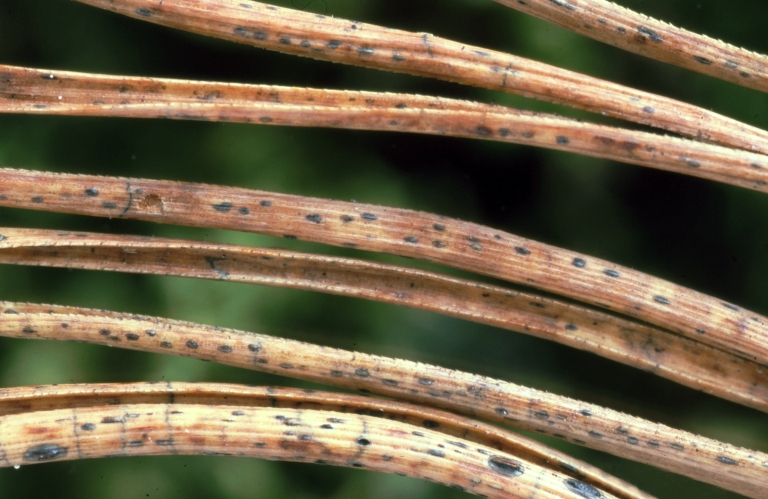This is the seventh part of a series on winter tree diseases and disorders. This article examines lophodermium needle cast and phomopsis blight of juniper.
Introduction
During the winter months, many of the fungal pathogens that affect trees enter dormancy. The pathogens overwinter on their hosts or in the soil, awaiting spring’s arrival. Despite the frigid temperatures, trees suffering from fungal diseases may still exhibit infection symptoms in winter, especially if the disease has advanced into its later stages. The following describes some of the most common diseases to overwinter on trees, and how they may be detected.
Lophodermium Needle Cast
Lophodermium needle cast is a fungal disease that affects two and three needled pines, as well as some five needled pines. The disease is caused by the fungus, Lophodermium seditiosum. Infected needles are often shed from the tree. Significant defoliation can disfigure infected trees, and reduce tree vigor. Severe infections may culminate in tree mortality.
Hosts
Lophodermium needle cast commonly infects Scots and red pines. Ponderosa, Monterey, Virginia, and Austrian pines have also been reported as hosts, albeit with less frequency.
Symptoms of Infection
In early spring, brown spots, or bands with yellow margins, appear on the previous year’s needles. As the spots or bands enlarge, the entire needle turns yellow, and then reddish-brown as the shoots become elongated. Severe infections will cause the crown of infected trees to appear scorched, with only tufts of green current-season needles remaining at the tips of branches. As the disease advances, infected needles generally drop from the tree. Defoliation often begins on the lower portion of the crown, before progressing upwards. In late summer, slightly raised, small, black fruiting bodies appear on the dead needles. The fruiting bodies are aligned length-wise on the needles. They feature a characteristic slit in their center, which splits open to release minute spores when conditions are sufficiently moist. These fruiting bodies may also be observed on cast needles under the tree. The current season’s growth will generally not exhibit symptoms of infection.
Management
- When planting, select trees that are genetically resistant to the disease. Avoid planting susceptible trees in low areas with poor soil drainage. Adequately space trees to encourage the drying of foliage, and limit sporulation.
- Remove weeds growing around and under trees to improve air circulation, and the drying of foliage.
- In early spring, inspect needles for symptoms of infection. Severely infected limbs, and needle litter should be removed, and destroyed to prevent sporulation.
- Maintain tree vigor through sound cultural practices. Ensure that trees are sufficiently watered, especially during extended periods of drought. Apply a layer of organic mulch around the base to improve soil quality, moderate soil temperature, and maintain soil moisture.
- Registered fungicides can be applied three to four times during the growing season. Initial applications should be performed in early July, when the current year’s needles have fully expanded. Subsequent applications should be administered at three week intervals.
Phomopsis Blight of Juniper
Phomopsis blight of juniper, also called twig blight of juniper, nursery blight, cedar blight, juniper blight, or needle blight is a significant fungal disease of eastern red cedar, and other junipers. It is caused by the pathogen Phomopsis juniperovora. The disease causes a progressive dieback of infected needles and stems. Severe infections can result in plants being partially to completely defoliated. Infected plants generally decline rapidly, and may expire.
Hosts
Phomopsis blight of juniper most commonly infects eastern red cedar, creeping juniper, Rocky Mountain juniper, and Savin juniper. Arbovitae, Chinese juniper, common juniper, cypress, Douglas-fir, English yew, European larch, false cedar, fir, jack pine, Japanese cedar, Japanese plum yew, true cedar, and white cedar may also be infected.
Symptoms of Infection
Yellow spots form at the tips of new needles. As the infection advances from the needles into the stems, it causes the new shoot tips to turn brown, and die back. The infection will then progress into the main stem, resulting in a progressive dieback of infected needles and branches. Infected needles will initially turn light green, before darkening to a reddish-brown, followed by an ashen grey. Lesions frequently develop on infected stems. Small stems are typically girdled by these cankers. When the fruiting bodies are mature, they can be observed as small, black spots on infected plant material. Defoliation generally occurs on the lower or central portions of infected plants. Severe infections may cause plants to be entirely defoliated. Plants that suffer from repeated blight infections may eventually fail.
Management
- Promptly remove infected branches to prevent the spread of the disease.
- Cull dead or severely infected plants. Dispose of all diseased plant material. Avoid composting any infected plant debris.
- Numerous fungicides are registered for use in control of phomopsis blight. Applications should begin in early spring, as the pathogen becomes active. To effectively control the disease, applications should be performed at 10 to 14 day intervals, until mid-summer. Applications may resume in fall, if conditions are conducive to infection.
- When planting, select varieties that exhibit an increased resistance to blight infection.
- Use irrigation or soaker hoses to water plants. Try to keep foliage from being drenched with water.
- Prune vulnerable plants to improve air circulation, and promote a rapid drying of the foliage.
- Maintain plant vigor through sound cultural practices.
- Ensure that plants are sufficiently watered, especially during extended periods of drought.
- Apply a layer of organic mulch around the base of susceptible plants to improve the soil quality, and retain soil moisture.
Photo courtesy of Petr Kapitola CC-by-3.0


